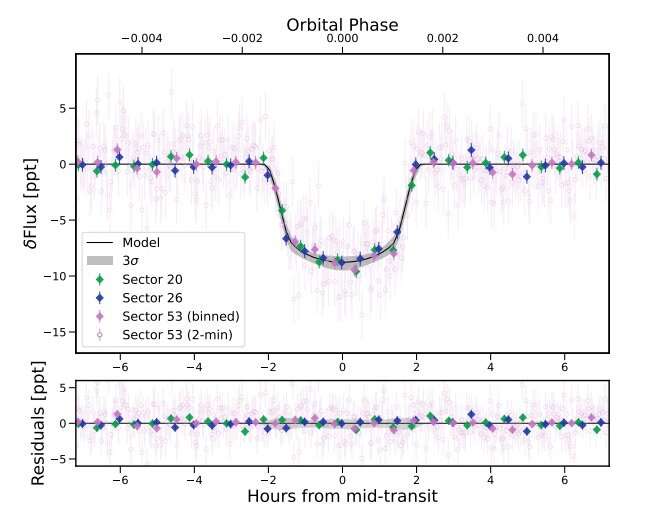April 6, 2023 report
This article has been reviewed according to Science X's editorial process and policies. Editors have highlighted the following attributes while ensuring the content's credibility:
fact-checked
preprint
trusted source
proofread
Astronomers discover a warm Jupiter-sized exoplanet

Using NASA's Transiting Exoplanet Survey Satellite (TESS), an international team of astronomers has detected a new, warm Jupiter-sized exoplanet orbiting a dwarf star. The newfound alien world, designated TOI-4127 b, is more than two times as massive as Jupiter. The finding is reported in a paper published March 25 on the arXiv pre-print server.
TESS is conducting a survey of about 200,000 of the brightest stars near the sun with the aim of searching for transiting exoplanets. So far, it has identified over 6,200 candidate exoplanets (TESS Objects of Interest, or TOI), of which 3,031 have been confirmed so far.
A group of astronomers led by Arvind F. Gupta of the Pennsylvania State University (PSU) now confirmed another TOI monitored by TESS. They report that a transit signal has been identified in the light curve of a late F-type dwarf star known as TOI-4127. The planetary nature of this signal was confirmed by follow-up spectroscopic observations.
"In this work, we present the discovery of the highly eccentric warm Jupiter TOI-4127 b with TESS, and the confirmation and characterization of the exoplanet signal with the NEID and SOPHIE spectrographs," the researchers wrote.
According to the paper, TOI-4127 b has a radius of nearly 1.1 Jupiter radii and its mass is 2.3 Jupiter masses, yielding a density of approximately 2.17 g/cm3. The planet orbits its host every 56.4 days, at a distance of some 0.31 AU from it, on a highly eccentric orbit—with an eccentricity of almost 0.75. The equilibrium temperature of TOI-4127 b was estimated to be about 605.1 K, therefore the planet was classified as a "warm Jupiter."
By analyzing the parameters of TOI-4127 b, the researchers concluded that the planet may be a "hot Jupiter" progenitor, but only if a perturbing companion is present. The so-called hot Jupiters have similar characteristics to the solar system's biggest planet, with orbital periods of less than 10 days. Such exoplanets have high surface temperatures, as they orbit their parent stars very closely.
"It is assumed that warm Jupiters may spend a fraction of their lives on a high-eccentricity tidal migration track if they are subject to secular eccentricity oscillations, through which they exchange angular momentum with a distant perturber to periodically reach higher eccentricities and tighter pericenter distances than presently observed," the authors of the paper explained.
In the case of the TOI-4127 system, the present periastron separation of the newfound planet is too large for high-eccentricity tidal migration to circularize its orbit. The astronomers noted that TOI-4127 b is unlikely to be a hot Jupiter progenitor unless it is undergoing angular momentum exchange with an undetected outer companion. However, so far no evidence of additional bodies in this system have been found.
When it comes to the parent star TOI-4127, it has a radius of nearly 1.3 solar radii and a mass of approximately 1.23 solar masses. The star is about 4.8 billion years old, has a metallicity at a level of 0.14, and its effective temperature is 6,096 K.
More information: Arvind F. Gupta et al, A High-Eccentricity Warm Jupiter Orbiting TOI-4127, arXiv (2023). DOI: 10.48550/arxiv.2303.14570
Journal information: arXiv
© 2023 Science X Network




















